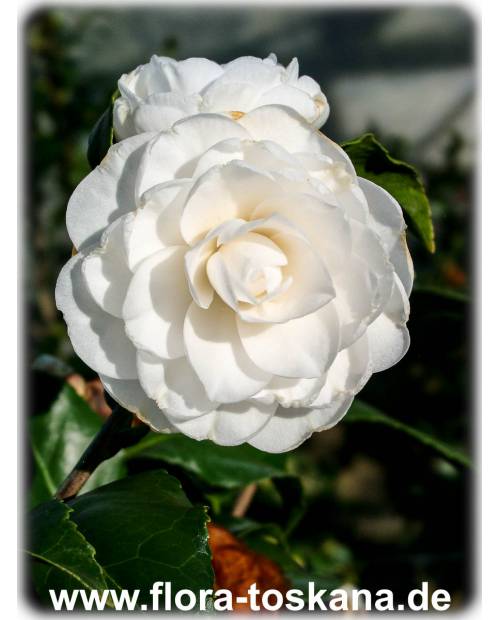Camellia japonica 'Mathotiana' - Camellia
Densely double, deep red flowers and the large, dense habit make this variety eye-catching ornaments for the garden and conservatory. Very good winter hardiness (hardiness zone 7b), compact growth and glossy dark green leaves add to the attractiveness of this Belgian cultivar from the 19th century.
![]() General information on Japanese Camellia: The evergreen shrubs with the glossy, leathery dark green leaves love semi-shady places and acidic, well drained but moist, humus-rich soil as well as acidic fertilizers (e.g. rhododendron fertilizer). Their thick flower buds are already formed from (late) summer, ripen from about September until flowering in February/March/April at 0 to 10 °C, and open in cool places around 10 °C. If the temperature is too high, the buds will fall off before they open: Japanese Camellias are not houseplants! But they are wonderful winter garden plants, which rightly bear the nickname "Roses of Winter". Or – due to their surprisingly high winter hardiness, depending on the variety – they can be planted out as permanent guests in the garden, protected from the winter sun with a shade net or fleece. When planted in the garden, flowering starts (depending on the weather) a few weeks later than potted Camellia in a conservatory.
General information on Japanese Camellia: The evergreen shrubs with the glossy, leathery dark green leaves love semi-shady places and acidic, well drained but moist, humus-rich soil as well as acidic fertilizers (e.g. rhododendron fertilizer). Their thick flower buds are already formed from (late) summer, ripen from about September until flowering in February/March/April at 0 to 10 °C, and open in cool places around 10 °C. If the temperature is too high, the buds will fall off before they open: Japanese Camellias are not houseplants! But they are wonderful winter garden plants, which rightly bear the nickname "Roses of Winter". Or – due to their surprisingly high winter hardiness, depending on the variety – they can be planted out as permanent guests in the garden, protected from the winter sun with a shade net or fleece. When planted in the garden, flowering starts (depending on the weather) a few weeks later than potted Camellia in a conservatory.![]() Quality: pink, peony-shaped flowers; evergreen & glossy leaves; compact growth; very good winter hardiness
Quality: pink, peony-shaped flowers; evergreen & glossy leaves; compact growth; very good winter hardiness
![]() Use: planted in the garden; outdoors in pots from March/April in a semi-shaded place - during winter in an unheated room; all year in an unheated or rarely heated greenhouse or conservatory
Use: planted in the garden; outdoors in pots from March/April in a semi-shaded place - during winter in an unheated room; all year in an unheated or rarely heated greenhouse or conservatory
Data sheet
- Family
- Theaceae
- Origin
- Asia (mediterranean)
- Flowering period
- Winter
- Color of flowers
- Red
- Growth
- Shrub
- Location
- Shadow
- winter temperature
- 5 (+/- 5) °C
- Minimum temperature
- -15 °C
- Hardiness Zones
- 7
- Height
- 2 - 2,5 m
You might also like
Customers who bought this product also bought:
































